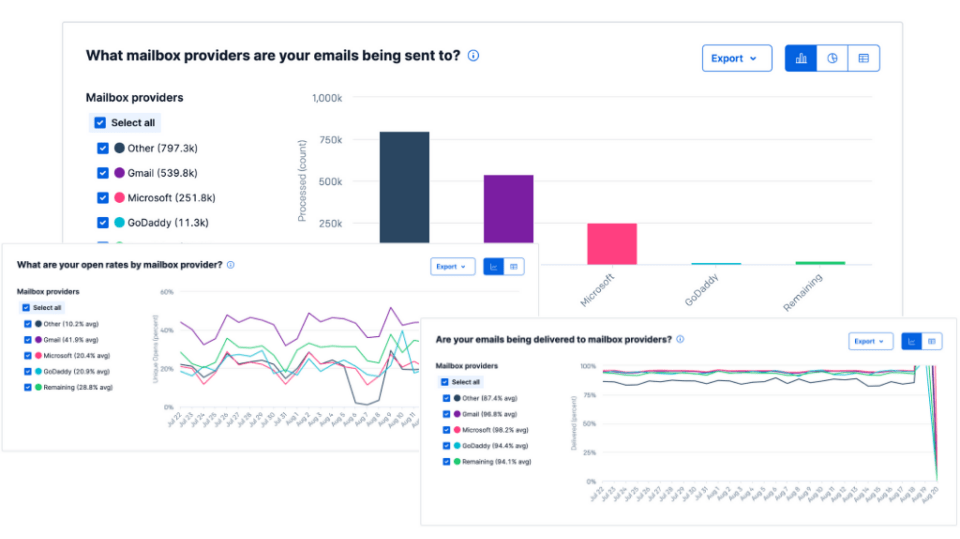Mailjet vs SendGrid: The best email marketing solution for your business
- 01Mailjet vs SendGrid: overview
- 02What's the difference between Mailjet and SendGrid?
- 03Mailjet pros and cons
- 04SendGrid pros and cons
- 05Mailjet compared to SendGrid
- 06SendGrid compared to Mailjet
- 07Features comparison
- 08Mailjet vs SendGrid: Which is the best for your business?
- 09Promotions on Email Marketing software
- 10Alternatives to Mailjet & SendGrid
Many businesses rely heavily on email communication as a vital component of their operations, be it for marketing campaigns, transactional messages, or customer support. However, choosing the right email service provider is crucial for ensuring deliverability, engagement, and overall success. In this comparison, we'll delve into Mailjet and SendGrid, two prominent players in the email service industry.
Mailjet and SendGrid offer powerful tools for managing email campaigns, transactional messages, and customer engagement. To assist you in determining which platform best suits your needs, we'll conduct a thorough examination of their features, functionalities, and pricing models. Let's explore the differences between Mailjet and SendGrid!
Mailjet vs SendGrid: overview
Mailjet and SendGrid are both industry-leading email marketing software, each offering a unique set of features and functionalities tailored to meet diverse business needs.
Mailjet is recognized for its user-friendly interface and robust email marketing tools. It excels in delivering personalized campaigns, transactional emails, and marketing automation with ease. Additionally, Mailjet provides advanced analytics and real-time monitoring to track the performance of email campaigns effectively. SendGrid, on the other hand, stands out for its scalable infrastructure and high deliverability rates. It offers powerful APIs for seamless integration with existing systems, making it a preferred choice for developers and enterprises.
To assist you in making an informed decision between Mailjet and SendGrid, we'll delve deeper into their features, performance, and pricing models. Let's dive into the Mailjet vs. SendGrid comparison to determine the best email service provider for your specific business needs.
What's the difference between Mailjet and SendGrid?


When comparing Mailjet and SendGrid, two of the most prominent email service providers, it's essential to consider their unique features and approaches to email management. While both platforms offer robust tools for sending marketing campaigns, transactional emails, and managing subscriber lists, there are key differences that may influence your decision.
One significant difference between Mailjet and SendGrid lies in their user interfaces and ease of use. Mailjet is known for its intuitive dashboard and user-friendly design, making it accessible to users of all technical levels. With its straightforward navigation and clear organization of features, Mailjet is ideal for beginners and experienced marketers alike.
SendGrid, on the other hand, is favored by developers and tech-savvy users for its extensive API documentation and advanced customization options. While SendGrid also offers a user-friendly interface, its emphasis on integration and customization sets it apart. Developers appreciate SendGrid's flexibility in integrating with existing systems and building custom email solutions tailored to specific business needs.
Another crucial difference between Mailjet and SendGrid is their pricing structure and scalability. Mailjet offers tiered pricing plans based on the volume of emails sent per month, with additional features such as advanced analytics and dedicated IP addresses available at higher tiers. In contrast, SendGrid's pricing is based on the number of email credits purchased, with discounts available for higher volumes. Additionally, SendGrid offers a flexible pay-as-you-go option, making it suitable for businesses with fluctuating email sending needs.
If you prioritize user-friendliness and simplicity, Mailjet may be the preferred option. However, if you require extensive customization and integration capabilities, SendGrid offers a comprehensive solution for developers and advanced users.
Mailjet pros and cons
What are the advantages of Mailjet?
- User-friendly interface: Mailjet offers an intuitive and easy-to-navigate interface, making it accessible for users of all technical levels.
- Advanced automation: With Mailjet, users can leverage advanced automation features to create personalized email campaigns and workflows, streamlining marketing efforts and improving engagement.
- Powerful analytics: Mailjet provides comprehensive analytics and reporting tools, allowing users to track the performance of their email campaigns in real-time and make data-driven decisions for optimization.
- Global deliverability: Mailjet boasts high deliverability rates and robust infrastructure, ensuring that emails reach recipients' inboxes reliably, regardless of their location.
- Scalability: Whether you're a small business or a large enterprise, Mailjet offers scalable solutions that can grow with your needs, accommodating varying email sending volumes and requirements.
What are the disadvantages of Mailjet?
- Limited templates: While Mailjet offers some pre-designed email templates, the selection may be limited compared to other email marketing platforms, potentially limiting design options for users.
- Integration challenges: Integrating Mailjet with other third-party tools or platforms may require technical expertise, as the process can be complex and may not always be seamless.
- Support limitations: Some users have reported challenges with customer support response times and the availability of resources, particularly for users on lower-tier plans.
- Complex pricing structure: Mailjet's pricing structure, while flexible, can be complex to understand, especially for users who are new to email marketing or have fluctuating email sending volumes.
- Spam filtering issues: While Mailjet strives for high deliverability rates, some users have experienced issues with emails being flagged as spam, potentially impacting the effectiveness of email campaigns. Regular monitoring and optimization may be necessary to mitigate this risk.
Compare Mailjet to other tools
SendGrid pros and cons
What are the advantages of SendGrid?
- High deliverability rates: SendGrid is known for its excellent deliverability rates, ensuring that emails reach recipients' inboxes reliably and avoiding spam folders.
- Robust API documentation: SendGrid provides extensive API documentation and developer resources, making it easy for developers to integrate and customize email functionalities into their applications.
- Scalability: SendGrid offers scalable solutions that cater to businesses of all sizes, from startups to enterprise-level organizations, allowing users to adjust their email sending volumes and features as needed.
- Advanced email marketing features: SendGrid offers a wide range of advanced email marketing features, including segmentation, A/B testing, and advanced analytics, empowering users to create targeted and effective email campaigns.
- Reliable infrastructure: SendGrid's infrastructure is highly reliable, with redundancy and failover mechanisms in place to ensure continuous email delivery and uptime.
What are the disadvantages of SendGrid?
- Complex pricing structure: SendGrid's pricing structure can be complex to understand, with various tiers and add-on options available. Users may find it challenging to estimate costs accurately, especially as email sending volumes fluctuate.
- Customer support: Some users have reported issues with SendGrid's customer support, including long response times and limited availability of resources for troubleshooting.
- Learning curve: While SendGrid offers powerful features, users may encounter a learning curve when initially setting up and configuring their email campaigns, especially for those who are new to email marketing or API integration.
- Limited email templates: SendGrid's selection of pre-designed email templates may be limited compared to other email marketing platforms, potentially requiring users to invest more time and resources in designing custom templates.
- Spam filtering challenges: Despite its high deliverability rates, SendGrid users may still encounter challenges with emails being flagged as spam, requiring ongoing monitoring and optimization efforts to maintain inbox placement.
Compare SendGrid to other tools
Mailjet compared to SendGrid
Mailjet and SendGrid are leading email service providers, each with distinct strengths. Mailjet offers an intuitive interface and advanced automation features, ideal for users seeking user-friendliness and personalized campaigns.
On the other hand, SendGrid excels in high deliverability rates and robust API documentation, catering to developers and businesses requiring scalable solutions. While Mailjet prioritizes ease of use and comprehensive analytics, SendGrid emphasizes reliability and customization options.
Is Mailjet better than SendGrid?
Choosing between Mailjet and SendGrid hinges on specific needs and preferences. If the priority is a seamless experience with efficient automation for crafting personalized email campaigns, Mailjet stands out with its user-friendly platform and detailed analytics that cater to marketers' needs for engagement tracking.
However, for those requiring high email deliverability and extensive customization through coding, SendGrid presents a more fitting choice with its superior API capabilities and emphasis on scalability. Thus, the decision between the two boils down to whether the user values an intuitive marketing tool or a developer-focused service with a strong foundation in technical robustness.
What is Mailjet best used for?
Mailjet is best used for managing and optimizing email marketing campaigns. Its user-friendly interface and advanced automation features make it ideal for businesses seeking to engage customers through personalized and targeted emails. Whether it's sending promotional newsletters, transactional emails, or automated workflows, Mailjet offers comprehensive tools for designing, scheduling, and tracking the performance of campaigns.
With its focus on deliverability and analytics, Mailjet empowers users to create impactful email strategies, build stronger customer relationships, and drive conversions. Whether you're a small startup or a large enterprise, Mailjet provides the necessary tools to effectively communicate with your audience and achieve marketing goals.
Can Mailjet replace SendGrid?
While Mailjet offers robust email marketing features and user-friendly interfaces, whether it can fully replace SendGrid depends on specific business needs. SendGrid's strengths lie in its high deliverability rates, extensive API documentation, and scalability, making it particularly suitable for developers and businesses with complex email requirements. However, for organizations prioritizing simplicity and ease of use, Mailjet may serve as a viable alternative.
While both platforms offer similar functionalities, including email sending, tracking, and analytics, businesses should carefully assess their unique requirements and preferences to determine whether Mailjet can effectively replace SendGrid as their preferred email service provider.
Is Mailjet cheaper than SendGrid?
Determining whether Mailjet is cheaper than SendGrid depends on various factors, including email sending volume, required features, and pricing plans. While both platforms offer tiered pricing models, Mailjet's pricing structure typically charges based on the number of emails sent per month, with additional features available at higher tiers.
On the other hand, SendGrid offers pricing based on the number of email credits purchased, with discounts for higher volumes. Businesses should evaluate their specific needs and compare pricing plans to determine which platform offers the most cost-effective solution for their email marketing requirements.
Is there a better Email Marketing software than Mailjet?
Determining if there is a "better" software than Mailjet depends on your specific email marketing needs and preferences. Mailjet stands out with its user-friendly interface, advanced automation features, and comprehensive analytics tools.
However, alternatives to Mailjet like SendGrid, Constant Contact, and Campaign Monitor may better suit certain users. SendGrid is renowned for its high deliverability rates and robust API documentation, while Constant Contact offers easy-to-use templates and customizable email campaigns. Campaign Monitor provides advanced segmentation options and personalized email content creation.
SendGrid compared to Mailjet
SendGrid and Mailjet are both prominent email service providers with distinct strengths. SendGrid is recognized for its high deliverability rates and extensive API documentation, making it a preferred choice for developers and businesses requiring scalable solutions. In contrast, Mailjet excels in its user-friendly interface and advanced automation features, catering to marketers seeking simplicity and personalized campaigns.
While SendGrid prioritizes reliability and customization options, Mailjet emphasizes ease of use and comprehensive analytics.
Is SendGrid better than Mailjet?
When weighing SendGrid against Mailjet, the choice largely depends on the user's priorities and the nature of their email campaigns. SendGrid shines for those in need of a robust platform that guarantees email deliverability and offers detailed API documentation, ideal for developers and companies looking for a scalable, customizable solution. Its focus on technical excellence and the ability to fine-tune every aspect of the email sending process appeals to a tech-savvy audience.
Conversely, if the emphasis is on simplicity, intuitive campaign management, and detailed analytics without a steep learning curve, Mailjet might fall short, highlighting SendGrid's strengths in performance and flexibility.
What is SendGrid best used for?
SendGrid is best used for managing and optimizing email delivery and engagement. With its robust infrastructure and high deliverability rates, SendGrid is ideal for businesses of all sizes seeking reliable email solutions. Whether sending marketing campaigns, transactional messages, or notifications, SendGrid ensures that emails reach recipients' inboxes promptly and reliably.
Additionally, SendGrid's extensive API documentation and developer resources make it a preferred choice for integrating email functionalities into applications and automating workflows. With its focus on scalability, reliability, and customization options, SendGrid empowers businesses to effectively communicate with their audience and drive engagement through email.
Can SendGrid replace Mailjet?
Whether SendGrid can fully replace Mailjet depends on specific email marketing needs. SendGrid excels in high deliverability rates, extensive API documentation, and scalability, making it suitable for businesses requiring robust email infrastructure and customization options.
However, Mailjet offers user-friendly interfaces, advanced automation features, and comprehensive analytics, ideal for marketers seeking simplicity and personalized campaigns. While both platforms offer similar functionalities, businesses should evaluate their unique requirements and preferences to determine whether SendGrid can effectively replace Mailjet as their preferred email service provider, considering factors such as deliverability, customization, and ease of use.
Is SendGrid cheaper than Mailjet?
The comparison of affordability between SendGrid and Mailjet isn't straightforward and hinges on the unique needs and scale of an organization's email marketing efforts. Both platforms provide flexible pricing models tailored to accommodate a range of requirements, from small-scale campaigns to extensive marketing operations.
SendGrid's pricing, focusing on email credits, allows users to purchase in bulk, potentially offering savings for large-volume senders who can benefit from discounts. Conversely, Mailjet's model, which scales with the number of emails sent, could be more accessible for those with predictable sending patterns or smaller volumes.
Is there a better Email Marketing software than SendGrid?
Deciding on an email service provider that surpasses SendGrid hinges on your unique email marketing requirements and preferences. SendGrid is acclaimed for its exceptional deliverability rates and detailed API documentation, making it a go-to for businesses in need of scalable and dependable email services.
Nonetheless, alternatives to SendGrid such as Brevo (ex. Sendinblue), Mailchimp, Mailgun, and MailerSend might align more closely with specific user needs. Brevo offers a holistic marketing platform with email services, SMS campaigns, and automation features. Mailchimp is known for its all-encompassing email marketing tools and sophisticated automation capabilities. Mailgun appeals to developers with its strong focus on deliverability and programmable API while MailerSend provides a straightforward and intuitive interface for transactional emails.
Features comparison
Mailjet Empowers Team Collaboration Unlike SendGrid

Mailjet provides a unique feature that sets it apart: the ability to facilitate team collaboration seamlessly. For example, it enables experts from various departments such as marketing, design, and content creation to share their ideas and expertise through shared documents and collaborative tools.
This collaborative approach streamlines the email marketing process, saving time and reducing costs associated with setting up and executing effective email campaigns. In contrast, SendGrid does not explicitly offer such robust team collaboration features, making Mailjet a preferred choice for businesses seeking efficient teamwork and productivity in their email marketing endeavors.
SendGrid Leads in Advanced Email Personalization

While both tools offer solid email personalization features, SendGrid edges out with its dynamic content feature. This capability allows you to create highly personalized emails using dynamic fields that can insert user-specific information such as purchase history or recommendations, in addition to base elements like names.
For example, SendGrid's dynamic content feature enables you to tailor email content based on each recipient's past interactions or preferences, enhancing relevance and engagement. This advanced level of personalization has the potential to significantly boost engagement rates and drive conversions, making SendGrid a preferred choice for businesses seeking highly targeted email marketing campaigns.
SendGrid Prioritizes High Deliverability for Email Success

A crucial aspect of any email service is the ability to land emails in recipients' inboxes reliably. SendGrid's standout feature is its steadfast focus on infrastructures to maximize email deliverability rates, ensuring that your important emails reach their intended recipients and significantly reducing the chance of landing in spam folders.
For example, SendGrid employs advanced algorithms and authentication protocols to optimize deliverability and inbox placement. While Mailjet also offers good deliverability, it doesn't emphasize this feature as strongly as SendGrid, making SendGrid the preferred choice for businesses prioritizing email success and engagement.
Mailjet Excels with Comprehensive Automated Trigger Campaigns

Mailjet's automated trigger-based campaigns stand out as a powerful feature not fully mirrored in SendGrid's offerings. For instance, Mailjet allows for the creation of various automated workflows such as welcome emails, abandoned cart reminders, and follow-up sequences based on user actions or specific triggers.
This functionality ensures timely and highly relevant communication with your subscribers, enhancing engagement and driving conversions. With Mailjet, businesses can leverage sophisticated automation capabilities to deliver personalized experiences to their audience, thereby maximizing the effectiveness of their email marketing efforts.
Mailjet Surpasses SendGrid with Intuitive User Interface

When it comes to user-friendliness, Mailjet notably edges out SendGrid. Mailjet's interface is explicitly designed with simplicity and intuitive usage in mind, making it accessible even for those who may not be tech-savvy. For example, Mailjet offers a sleek drag-and-drop email editor, allowing users to customize their emails effortlessly without the need for coding skills.
Moreover, the platform's navigation is fairly straightforward, with clearly labeled features and settings. In contrast, while SendGrid also boasts a user-friendly interface, some users might find its numerous features and options a bit overwhelming at first glance. Nonetheless, once accustomed, it becomes an incredibly powerful tool.
SendGrid Dominates Integration Possibilities

When it comes to integration capabilities, both SendGrid and Mailjet offer a selection of integrations across various categories such as CRM software, E-commerce, Marketing Automation, and Web Analytics. However, SendGrid takes the lead with its vast integration possibilities, providing over 100 pre-built integrations with leading platforms like Shopify, WordPress, and Salesforce. For instance, with SendGrid, you can seamlessly blend your email marketing efforts with your existing software stack, leveraging the power of integrated data and workflows.
While Mailjet also offers a solid range of integrations, it does not quite match up to the extensive catalog that SendGrid provides. In summary, deciding between Mailjet and SendGrid will largely depend on your specific needs. If ease of use is a top priority, Mailjet might be the better choice. Conversely, if integrating your email marketing platform into your existing software infrastructure is vital, SendGrid's broader array of integrations may be more suited to your needs.
Mailjet's Robust A/B Testing Outperforms SendGrid's

Both Mailjet and SendGrid provide A/B testing capabilities, but Mailjet's version is more comprehensive and insightful. For instance, Mailjet's A/B testing feature goes beyond basic metrics by offering in-depth analysis, allowing you to understand which components of your emails yield the best results.
With Mailjet, you can test different elements such as subject lines, sender names, and content variations to constantly optimize your email campaigns for maximum impact. This level of granularity in testing enables businesses to make data-driven decisions and refine their email marketing strategies effectively, ensuring higher engagement and conversion rates.
Subscribe to our newsletters.
No FOMO here. Stay up-to-date on all the latest deals and news with our monthly newsletter straight to your inbox like 124,000+ entrepreneurs (+ Get 10% off on on our Premium Membership!)
Mailjet vs SendGrid: Which is the best for your business?
Mailjet is the best tool for you if:
- You're looking for an intuitive email marketing platform that offers an easy-to-use interface, making it simple for beginners to create, send, and analyze their email campaigns efficiently.
- Your focus is on personalizing your email outreach with advanced segmentation and automation features, enabling you to deliver more targeted content to your audience for better engagement.
- You prioritize having access to detailed analytics and reporting tools to closely monitor the performance of your email campaigns, making informed decisions to optimize your strategies.
- Collaboration is key to your marketing strategy, as Mailjet provides collaborative tools that allow teams to work together on email designs and campaigns in real-time, ensuring consistency.
- Cost-effectiveness is a major consideration for your business, as Mailjet offers competitive pricing plans that scale with your needs, from free tiers to more advanced options without breaking the bank.
SendGrid is the best tool for you if:
- You're a developer looking for a service with robust API documentation and extensive integrations, allowing for seamless integration with your existing systems and flexibility in email customization.
- Your priority is achieving high deliverability rates, as SendGrid's sophisticated infrastructure and expertise ensure your emails consistently reach recipients' inboxes, crucial for critical communications.
- Scalability is key for your business, with SendGrid's infrastructure designed to handle large volumes of emails without compromising on performance, making it ideal for growing companies.
- You require detailed analytics and reporting features to monitor the success of your campaigns, offering insights into opens, clicks, and conversions to optimize future emails.
- Customization and control over your email campaigns are non-negotiable, as SendGrid provides a variety of tools to create, send, and manage emails that align with your brand.
Alternatives to Mailjet & SendGrid
Promotions on Email Marketing software
Start saving on the best SaaS with Secret.
Secret has already helped tens of thousands of startups save millions on the best SaaS like Mailjet, SendGrid & many more. Join Secret now to buy software the smart way.










